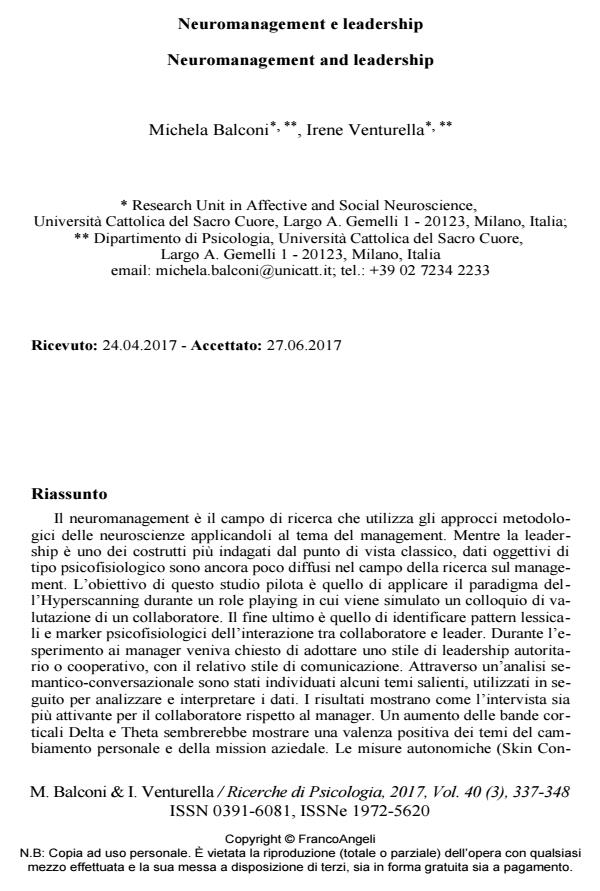Neuromanagement and leadership
Journal title RICERCHE DI PSICOLOGIA
Author/s Michela Balconi, Irene Venturella
Publishing Year 2017 Issue 2017/3
Language Italian Pages 12 P. 337-348 File size 230 KB
DOI 10.3280/RIP2017-003005
DOI is like a bar code for intellectual property: to have more infomation
click here
Below, you can see the article first page
If you want to buy this article in PDF format, you can do it, following the instructions to buy download credits

FrancoAngeli is member of Publishers International Linking Association, Inc (PILA), a not-for-profit association which run the CrossRef service enabling links to and from online scholarly content.
Neuromanagement deals with neuroscience methodological approaches to the management field. Leadership is a well-known management’s construct, but objective psychophysiological data supporting this statement, are still missing. The present pilot study aimed to apply the hyperscanning paradigm during a roleplayed employees’ evaluation. Our purpose was to identify lexical and neuro/psychophysiological markers of leader-employee interactions. The sample consisted in paired manager-collaborator couples. Managers were asked to use two different communication styles: authoritative vs. cooperative. Main topics were identified thanks to a conversational analysis; this permitted to interpret da-ta. Results showed that the interview was more arousing for the employee than for the manager. An increasing of Delta and Theta cortical bands could denote positive valence of personal change and company mission topics. Autonomic measures (Skin Conductance Response and Heart Rate) showed important information related to different leadership style and to the role inside the company. Results highlight the importance of applying neurosciences to organizational con-texts exploring processes related to manager-employee dynamics and communicative style. In particular hyperscanning paradigm seems to be useful to investigate interpersonal dynamics and their psychophysiological markers during an important phase of management conduction: employees’ evaluation.
Keywords: Management, leadership, hyperscanning technique, communicative style.
- “We will be in touch”. A neuroscientific assessment of remote vs. face-to-face job interviews via EEG hyperscanning Michela Balconi, Federico Cassioli, in Social Neuroscience /2022 pp.209
DOI: 10.1080/17470919.2022.2064910
Michela Balconi, Irene Venturella, Neuromanagement e leadership in "RICERCHE DI PSICOLOGIA " 3/2017, pp 337-348, DOI: 10.3280/RIP2017-003005